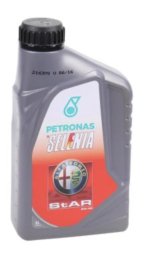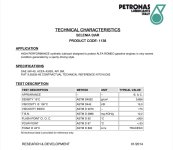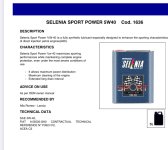Pennzoil Platinum Euro 5W-40 is what USA Alfa dealers get as Stellantis/FCA/Fiat/Alfa's official oil to use for Quadrifoglio oil changes. (Some may also offer other alternatives, such as the Selenia, not sure.)
From the 2022 MOPAR Lubricant catalog:
View attachment 142408
The 2023 Stelvio manual states (in the section on the 2.0L car, but definitely should be taken as applicable to the Quadrifoglio as well, since it's also a GDI turbo car whose engines have been reported by owners even at low milage of having misfires/knocks/failures that could be due to LSPI, and I don't trust people who make manuals to know which row to put things in):
View attachment 142409
Pennzoil Platinum Euro 5W-40 is API SP, ILSAC GF-6A rated. Very few other oils you can find will have these approvals yet. (This would be somewhat like an oil being ACEA A7/B7/C6 since those are the only ACEA standards with LSPI testing requirements.)
Based on actual tests I've seen, this is very comparable to AMSOIL SS or any other top-tier oil.
Informal tests I've seen from a Russian YouTuber showed that Pennzoil Platinum Euro 5W-40 outperformed Shell Helix Ultra 5W-40 by about 2x in a couple of evaporation tests. They're not the same oil, but it might be the same as Shell Helix Ultra
Racing 5W-40 (not sure, haven't checked).
Other informal tests of Pennzoil Platinum Euro 5W-40 seen seem consistent with this oil having a Noack score of 6-7% (ASTM D-5800), but until Shell publishes some official numbers we won't know for sure, and the tests I found on YouTube were not done using a very scientific setup.
Shell might be withholding their D-5800 results because of the recent controversy around the repeatability of those tests. Maybe there was a lawsuit in the USA. Maybe they're afraid it will make their GTL formula easier to reverse engineer.
Lastly, I've seen an "oil tournaments' where Pennzoil's Platinum 5W-30 placed #2, though the margin of victory by the AMSOIL SS was so tiny that one should not feel like you're missing out on something by not using AMSOIL (though I'm sure their legion of sales reps can tell you why it's better).
Bottom line: the MOPAR dealer oil is perfectly fine. MOPAR is going to give you the best oil on the market for your car. There's no evidence or repeatable tests that I could find to back up any anti-GTL fear-mongering.
As to "Fiat 9.55535-GH2", only the Italians actually know what the hell it means, but I highly doubt it has stricter requirements than API SP and ILSAC GF-6A. But you should know that Shell Helix Racing 5W-40 is the official oil of Ferrari for the F154 engine in the California T, upon which the Alfa Romeo 690T engine is based, and Shell Helix 5W-40
was listed as Fiat 9.55535-GH2 compliant back in 2015 (which was before this was listed as being GTL-based, though) as the official oil of Maserati for their version of the same engine. Given that Pennzoil Platinum Euro 5W-40 performs even better than Shell Helix in the testing of a Russian YouTuber; is made by the same company (Shell) using the exact same base oil; and is the official MOPAR oil for this car, then I don't think it should worry you that it doesn't say "GH2" in the spec sheets. (Though I'm going to email Pennzoil nonetheless and find out why.)
PURE SPECULATION: If I had to guess, I'd suspect that GH2 might require a PAO (Group IV) base. If so, that would explain why none of the GTL-based oils (which are Group III, technically speaking) are listed as GH2.
If you feel more comfortable putting Group IV oil GH2 oil in your car, and/or an oil with a listed Noack score, and/or one that's ASEA C3 listed, then I'd probably go with the Ravenol VST since it has GH2 spec, Ravenol RUP (racing) since it has C3 spec (and is probably better for track days anyhow), Ravenol RCS (if you want the lowest possible Noack score as if 1-2% matters), or of course you could run Selenia Quadrifoglio. However NONE of those oils lists LSPI protection nor are API SP / ILSAC GF-6A rated.
Personally I'd rather take my chances with GTL and its unlisted Noack score than risk an oil that suffers from LSPI blowing my engine up. Just me though!



